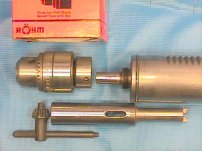I just purchased a Clausing 16VC from the 1960s. It had an older Jacobs chuck in rough shape, so I bought a new keyless chuck, Jacobs model JK-130-J33.
The arbor is JT33.
I removed the old chuck and installed the new one but could see significant runout.
Measured runout about 1” down a 1/2” drill rod is 0.0215.
The runout at about the same spot down the drill rod on the old chuck is 0.012.
I confirmed the drill rod is consistent diameter and straight.
Putting two indicators on the arbor, I measured the runout at 0.0015, as shown in this video -
.
I also ran the quill up/down with a test indicator mounted and found about 0.0065 difference from top to bottom over about 4” with the new chuck. Same measurement was about 0.003 with the old chuck.
Any ideas? Is 0.0015 runout acceptable at the arbor? Could the rest be coming from the chuck or install method?
Thanks.
The arbor is JT33.
I removed the old chuck and installed the new one but could see significant runout.
Measured runout about 1” down a 1/2” drill rod is 0.0215.
The runout at about the same spot down the drill rod on the old chuck is 0.012.
I confirmed the drill rod is consistent diameter and straight.
Putting two indicators on the arbor, I measured the runout at 0.0015, as shown in this video -
I also ran the quill up/down with a test indicator mounted and found about 0.0065 difference from top to bottom over about 4” with the new chuck. Same measurement was about 0.003 with the old chuck.
Any ideas? Is 0.0015 runout acceptable at the arbor? Could the rest be coming from the chuck or install method?
Thanks.


